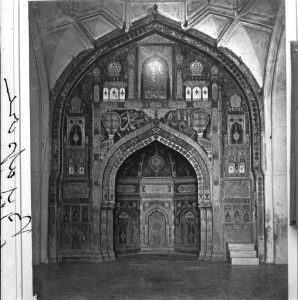June 24, 2021, by Kathryn Steenson
Images of India
Around 100 years ago, Professor Henry Hurd Swinnerton learned that 300 old glass plate negatives were about to be thrown out. Glass plate negatives are thin sheets of fragile glass coated in light-sensitive chemicals, and by the late 1930s they were becoming obsolete. These particular negatives of 19th century India were a little damaged and not all of them were labelled, but Swinnerton was Head of the Department(s) of Geology and Geography, and he saw value in them.
The slides were saved from the bin.
In 2017, as part of our Threads of India exhibition, we embarked on digitising and cataloguing them, displaying a selection for the first time in decades. Recently we’ve been creating an online gallery of the complete set, which will shortly go live as part of NuSearch’s Digital Galleries.
Many of the original images were taken in the 1860s and 1870s, and depict monuments, landscapes and people. Some of these images were published in a book by James Wilkinson Breeks, the Commissioner of the Nilgiris who wished to make a record of the indigenous hill-tribes of the region before their way of life, customs and legends died out due to increasing western influences. Others may have been taken by Eugene Clutterbuck Impey, a soldier and administrator based in India who photographed architecture and landscapes for a book. We know for sure that some were taken by Captain Edmund David Lyon, former Governor of Dublin District Prison (Military) who was commissioned by the Madras and Bombay (now Chennai and Mumbai) Governments to photograph archaeological and architectural antiquities in South India. Other images may have been taken by as yet unidentified photographers.
And this is where we need your help. We can’t be sure when, where or by whom some of the images were taken. There are dozens and dozens of slides missing details, and we’ve put a selection of them in this post.

Image showing men outside an unidentified decorative building. Labelled ‘Amba Jeypore’.
Ref: MS 148/12/225
This grand building is probably in Jeypore, and it looks as though a uniformed man is standing guard at the entrance. In contrast is building on the right, hemmed in by the foliage, and this time only watched over by a single man crouched near the water.
Another contrast between the abandoned temple with its empty pool on the left, and a well-tended temple garden with a watering can and flowering plants. Judging from the slight blur of the flowers, there was probably a light breeze when the photo on the right was taken.
Both of these images were unlabelled. This ornate gateway on the left leads out to what looks like a fairly quiet street, although perhaps the photographer was choosing his moment. The religious building on the right is definitely deserted in this image and in another taken from a slightly different angle.
Close-ups of two religious buildings, one possibly a mosque in Kerala and the other possibly a Hindu temple in Karnataka. But we can’t be sure.
And finally, below, another grand complex with a bridge. We think we’ve read the handwritten label correctly, but if that’s a phonetic spelling of a place then it has us stumped. Lastly is one of my personal favourite images – somewhere in Delhi, about 140 years ago, two boys climbed up to a roof and were immortalised by an unknown photographer as they jumped into the water below.
If you can help provide any details about these images, please leave a comment or email us mss.library@nottingham.ac.uk.
No comments yet, fill out a comment to be the first










Leave a Reply